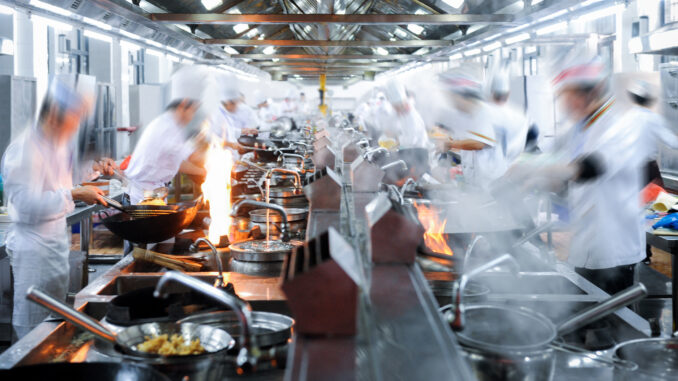
By Francine L. Shaw, food safety specialist - 4.3.2024
There’s been a perfect storm of foodborne illnesses lately, with norovirus and Hepatitis A cases rising, plus salmonella, listeria, and E coli outbreaks occurring at alarming frequencies. These incidents should serve as a wake-up call for restaurants (and other food businesses), who must constantly (and consistently) prioritize proper disinfection and sanitation protocols.
Consider that:
- Norovirus, the top foodborne illness in the U.S., has been occurring more frequently. While 20 million people get norovirus annually, infected foodservice workers cause approximately 70% of the reported outbreaks. When infected workers don’t wash their hands, disinfect surfaces, and follow proper safety protocols, they can contaminate foods and pass the highly contagious illness to customers.
- Hepatitis A cases are also increasing. Since the Hepatitis A virus can survive in water and on surfaces for extended periods, it can be transmitted by consuming contaminated food or water. Like norovirus, Hepatitis A has been frequently linked to infected food-handlers, but unlike norovirus, Hepatitis A is vaccine preventable.
- Various foods have been tainted with salmonella (cantaloupe, charcuterie meats, etc.), listeria (queso fresco, cotija cheese, and stone fruits) and E coli (raw milk and raw milk cheeses). These frequent, highly publicized foodborne illness outbreaks have shaken consumer confidence in food safety.
In the U.S., more than 60% of foodborne illness outbreaks occur in restaurants. Therefore, restaurant employees – like all foodservice workers – must follow proper sanitation protocols to keep their facilities clean and safe.
Be Proactive About Food Safety
Restaurants and other foodservice settings are busy places, but it’s imperative that these businesses prioritize food safety. One simple mistake – like skipping handwashing, not properly sanitizing surfaces, or using an ineffective disinfectant – can cause a food safety breach that could sicken your guests and damage your brand’s reputation.
Food brands should do the following to minimize risks and maximize safety:
- Rely on technology. Implement advanced technologies – including AI, machine learning, IoT, and digital technology – to improve food safety. For instance, AI monitors and analyzes quality parameters, ensuring the highest standards are maintained. Tech tools can also uncover trends and gather insights, empowering business leaders to make more informed, data-driven decisions. By embracing innovative tools – plus following strict protocols – restaurants can elevate food safety, mitigate risks, boost consumer trust, and foster continuous improvement.
- Use HOCL. Many food brands are now relying on Hypochlorous acid (HOCL), which is effective against 99.99% of pathogens and 80-100x more effective than bleach, yet is non-toxic, and safe for humans and the environment. HOCL kills numerous pathogens, including norovirus, COVID, hepatitis A, listeria, and salmonella. Unlike other solutions, HOCL is safe and effective on (and around) foods, and is compliant with CDC, FDA, and EPA regulations. Companies like EcoloxTech are becoming more widely known for providing HOCL generators that produce HOCL onsite at a fraction of the cost of bottled HOCL, which restaurant brands like Dr. Smood appreciate. Rene Sindlev, CEO of Dr. Smood, said his company depends on HOCL as “a safe and natural solution to disinfect and eradicate pathogens in fruits and vegetables. In addition to washing and disinfecting our raw produce and fruits, the electrolyzed water has shown spectacular results in prolonging the shelf life of our raw produce. Because electrolyzed water is 100% safe and non-irritant on the skin, we have also been using it for wash stations for our staff.”
- Sanitize and disinfect thoroughly. Restaurants must sanitize and disinfect often, using a safe and effective solution like HOCL. Be certain that you sanitize countertops, food prep areas, cutting boards, and utensils, as well as floors and high-touch areas, like doorknobs, sink handles, and light switches, to prevent the spread of germs.
- Sanitize foods. Reduce bacteria, pathogens, and foodborne illness risks by using food safe sanitizers (like HOCL) on your produce, meat, poultry, and seafood. This effort can extend these products’ shelf-life and cut safety risks dramatically. Studies also show the importance of using food safe sanitizers as a “kill step” when washing fruits and vegetables, to reduce or eliminate dirt, feces, and other contaminants.
- Ensure proper handwashing. Handwashing is the single most effective thing you can do to stop the spread of infection, and should be considered non-negotiable for all foodservice employees. Proper hand washing can help prevent foodborne illnesses and the spread of pathogens. For instance, feces is a common source of germs like Salmonella, E. coli, and norovirus. Germs from unwashed hands can be transferred to surfaces – like prep surfaces, utensils, or equipment – and foods.
- Don’t allow sick employees to work. If you’re short-staffed, it may be tempting to have an employee work while under-the-weather, but don’t allow it, especially if they’re vomiting or having diarrhea. Norovirus can be easily spread by infected workers in foodservice settings, putting customers, employees, and foods at risk. Prohibit employees to work when ill and don’t allow them to come back until they’ve been symptom-free for at least 24 hours.
- Consider food irradiation. Food irradiation uses ionizing radiation to treat food, enhance safety, and extend shelf life by reducing the presence of microorganisms and insects – comparable to pasteurization for milk and canning for fruits and vegetables. The FDA oversees the regulation of radiation sources used in food irradiation.
By following these steps, food businesses can effectively:
- Decrease the risk of foodborne illnesses, including salmonella, listeria, and E. coli.
- Reduce the risk (and spread) of contagious illnesses, including norovirus, Hepatitis A, RSV, influenza, and COVID.
- Maintain clean, sanitized environments.
- Show their unwavering commitment to safety and cleanliness.
- Protect their foods, customers, employees, and reputations.
Unfortunately, foodborne illnesses aren’t going away anytime soon, so it’s each restaurant’s responsibility to consistently follow gold standard safety protocols. Proactively follow the tips listed above to keep your customers, employees, and foods safer. By doing so, you’ll improve not only safety, but also key metrics like consumer trust, loyalty, and retention.
 Francine L. Shaw is a food safety specialist, podcaster, founder of Savvy Food Safety, co-founder of My Trusted Source, author of “Who Watches the Kitchen?”, and a successful entrepreneur, and speaker who spent 30+ years working in the foodservice industry. Her career has included performing services (operating partner, corporate/private trainer, health inspector, third party inspector, adjunct professor) in various sectors of the foodservice industry. She has written hundreds of articles for national trade magazines and appeared on Dr. Oz, the BBC World Series Radio, and iHeart Radio as a food safety expert.
Francine L. Shaw is a food safety specialist, podcaster, founder of Savvy Food Safety, co-founder of My Trusted Source, author of “Who Watches the Kitchen?”, and a successful entrepreneur, and speaker who spent 30+ years working in the foodservice industry. Her career has included performing services (operating partner, corporate/private trainer, health inspector, third party inspector, adjunct professor) in various sectors of the foodservice industry. She has written hundreds of articles for national trade magazines and appeared on Dr. Oz, the BBC World Series Radio, and iHeart Radio as a food safety expert.
Are you an industry thought leader with a point of view on restaurant technology that you would like to share with our readers? If so, we invite you to review our editorial guidelines and submit your article for publishing consideration.

